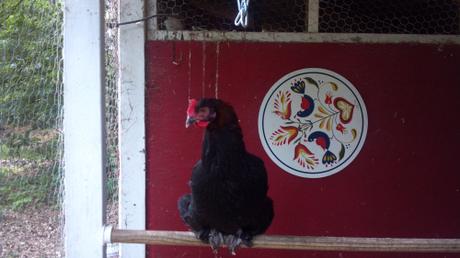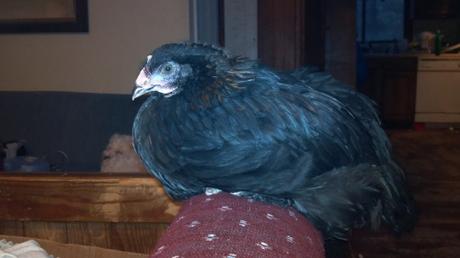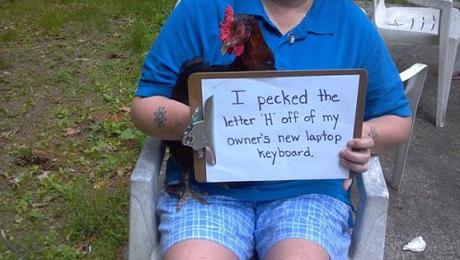
I have been sitting on this one for many months. It happened during our Border-to-border walk this summer and I knew I had to put it on the backburner until we finished, otherwise I would lose it.
Some chickens mean more than others.
And then it was too painful to retrieve it so I just let it sit and sit unattended. But it’s time to confront this head on.
My beautiful, beautiful Black Copper Maran, Charlie died. She had been ill for a while. Something was affecting her nervous system and she had difficulty walking. She’d list to one side, fall down, and then we’d have to pick her up and set her on her feet again. One day she’d be okay, the next day she’d have her “drunk dance” back.
As she continued with her declining health, we tried a few things. I gave her physical therapy (a towel sling while she worked her legs.) We made sure that she always had food and water nearby so that she wouldn’t have to go far. I picked her up at the end of the day to place her in the safety of the coop each night.
One night, when I was away on a walk, she finally laid down and died.
Charlie is the chick who came into our lives one January day following a Poultry Congress. When she was born her feet were fused and turned in. The breeder was going to do the right thing and have her put down.
“Let me try,” I begged. “Let me see what I can do.” The breeder relented and I came home, in the middle of winter with a newborn chick.

I set this tiny ball of fluff up in box in our living room. She had food, water, and although she couldn’t use it yet, a perch optimistically waiting for her. At that point Charlie couldn’t walk, every step she took, she’d tumble down and roll over. But it was okay because the kids were so enamored with her that her feet barely touched the ground anyway. They put her in blankets, cupped her in closed hands, and let her snuggle up and sleep in the curve of necks. Charlie soon learned who the members of her flock were.
As cute as she was, as much as we adored her, I knew that Charlie was in trouble. A chicken with non-functioning feet is a chicken that can’t scratch and one that can’t roost – both activities vital to the health and survival of a chicken.
The next day I enlisted my son’s help and while he firmly held the tiny chick, I slathered her feet in numbing Orajel. After a few moments, as carefully as I could, using surgical scissors (and holding my breath) I cut the webbing between her toes.
I had already made two tiny cardboard casts. After her toes were freed and antibiotic ointment applied, they were attached to the bottoms of her feet with Band-Aids.
And then we waited – she was either going to make it or not.
The next morning when I went in to check on her she looked up at me with her button black eyes and cheeped “good day.” Clearly this was one tough little bird.
Chicks grow quickly and so I knew I didn’t have much time. Charlie had to learn how to use her new feet. Each day I’d remove the casts for some physical therapy sessions (at first I used my finger as a perch and then I loved her to a dowel and eventually down to a pencil.)
Charlie thrived. Her feet healed and she had functioning toes. The only problem was that at 6 weeks when she was fully feathered and ready to join the coop, we still had snow on the ground.
“I can’t put her outside,” I told my husband. “She’d die.”
And that’s how, for 6 months we ended up having a chicken live in our house. She simply became a member of our indoor flock.
If I was making something in the kitchen, Charlie would be there hoping for a scrap of lettuce or a loose grape to fall to the ground (somehow it always did.)
When Charlie heard the TV being turned on, she’d run to the room, jump on to the back of the couch so that she could watch it with us.
I set up a nesting box by my computer and Charlie would spend hours patiently watching me write.
When it came time to roost with the flock at night, Charlie settled down with our dog Pippin, the two of them sleeping soundly in the dog bed.
But chickens poop. They poop a lot and even though I tried clicker training and diapers, the day came when it was time to move Charlie out to the coop.
Every day, every night when she was first moved to the coop, I checked on her. My mother hen instincts alerted to make sure she was okay, that she wasn’t being bullied by the other flock members.
Even though she learned to live in the coop, for years Charlie clearly preferred being inside our house. If someone left the door open, she’d run inside and start eating at her favorite place, Pippin’s dog bowl. Or she’d pop in to see if the TV was on (if it was, up on the couch she’d hop.) She’d run to the kitchen hoping for a treat on the floor.
Old habits die hard.
Mothers aren’t supposed to have favorites, but this mama hen has had a few favorites over the years.
Morganne – who acted like a puppy and would come running over when she saw me begging me to pick her up and start stroking her back.
Simon – our chicken who’s painting raised money for a local playground.
Isabelle – our special, coloring book chicken
Gimpy – the one who was attacked by a Fisher Cat and who defeated the odds and survived
And of course
Charlie – The chicken who lived in our house, became a full-fledged member of our family flock, and who stole our hearts.

***
Wendy Thomas writes about the lessons learned while raising children and chickens in New Hampshire. Contact her at [email protected]
Also, join me on Facebook to find out more about the flock (children and chickens) and see some pretty funny chicken jokes, photos of tiny houses, and even a recipe or two.
Like what you read here? Consider subscribing to this blog so that you’ll never miss a post. And feel free to share with those who may need a little chicken love.
Advertisements
